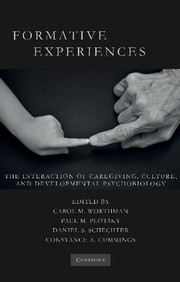Book contents
- Frontmatter
- Contents
- List of Figures
- List of Tables
- List of Contributors
- Foreword by Robert Sapolsky
- Preface
- List of Abbreviations
- Introduction
- SECTION ONE HISTORICAL, CROSS-CULTURAL, AND DEVELOPMENTAL SCIENCE PERSPECTIVES
- SECTION TWO HOW EXPERIENCE INTERACTS WITH BIOLOGICAL DEVELOPMENT
- SECTION THREE FORMATIVE RELATIONSHIPS WITHIN AND ACROSS GENERATIONS
- SECTION FOUR SOCIAL AND CULTURAL CONTEXTS OF CHILDHOOD DEVELOPMENT – NORMATIVE SETTINGS, PRACTICES, AND CONSEQUENCES
- SECTION FIVE FEAR, FUN, AND THE BOUNDARIES OF SOCIAL EXPERIENCE
- 15 Ethnographic Case Study: Anak PKI – A Longitudinal Case Study of the Effects of Social Ostracism, Political Violence, and Bullying on an Adolescent Javanese Boy
- Commentary
- Commentary
- 16 The Evolution of Social Play
- 17 Ethological Vignette: Social Stress as a Formative Experience – Neurobiology of Conditioned Defeat
- Commentary
- Commentary
- Commentary
- 18 The Basic Affective Circuits of Mammalian Brains: Implications for Healthy Human Development and the Cultural Landscapes of ADHD
- SECTION SIX PUBLIC HEALTH, EDUCATION, AND POLICY IMPLICATIONS
- Index
- References
16 - The Evolution of Social Play
Published online by Cambridge University Press: 26 May 2010
- Frontmatter
- Contents
- List of Figures
- List of Tables
- List of Contributors
- Foreword by Robert Sapolsky
- Preface
- List of Abbreviations
- Introduction
- SECTION ONE HISTORICAL, CROSS-CULTURAL, AND DEVELOPMENTAL SCIENCE PERSPECTIVES
- SECTION TWO HOW EXPERIENCE INTERACTS WITH BIOLOGICAL DEVELOPMENT
- SECTION THREE FORMATIVE RELATIONSHIPS WITHIN AND ACROSS GENERATIONS
- SECTION FOUR SOCIAL AND CULTURAL CONTEXTS OF CHILDHOOD DEVELOPMENT – NORMATIVE SETTINGS, PRACTICES, AND CONSEQUENCES
- SECTION FIVE FEAR, FUN, AND THE BOUNDARIES OF SOCIAL EXPERIENCE
- 15 Ethnographic Case Study: Anak PKI – A Longitudinal Case Study of the Effects of Social Ostracism, Political Violence, and Bullying on an Adolescent Javanese Boy
- Commentary
- Commentary
- 16 The Evolution of Social Play
- 17 Ethological Vignette: Social Stress as a Formative Experience – Neurobiology of Conditioned Defeat
- Commentary
- Commentary
- Commentary
- 18 The Basic Affective Circuits of Mammalian Brains: Implications for Healthy Human Development and the Cultural Landscapes of ADHD
- SECTION SIX PUBLIC HEALTH, EDUCATION, AND POLICY IMPLICATIONS
- Index
- References
Summary
INTRODUCTION
Voric runs up to Victor from behind. As he runs past him, he grabs Victor by the tuft of hair on the crown of his head. Victor jerks his body back, bracing against being pulled forward; this brings Voric to a standstill facing Victor. After looking at each other for a moment, Victor turns his head and lunges, with his mouth wide open, and attempts to bite Voric's hand, which is still grasping Victor's hair. As Voric releases his grip and withdraws his hand, he simultaneously lunges forward, grabbing Victor by both shoulders, and tries to bite the side of his neck. Victor ducks and rolls onto his side. Voric follows, falling on top of him. They then grapple, and, when possible, gently deliver bites at each other. After a few seconds, Voric jumps up. He begins to run away, but then slows down, and with a wide-open mouth, looks back over his shoulder at Victor. While slow to rise at first, Victor now bolts upright and chases after Voric, who disappears into the bushes.
This description of play-fighting in two Tonkean macaques (Macaca tonkeana) taken from our research videotapes (Primate Research Centre, Strasbourg, 1996) could well represent almost any mammal. Intriguingly, two researchers who watched young rhesus macaques (Macaca mulatta) play like this drew fundamentally different conclusions about why they played. One claimed that the monkeys were rehearsing skills they would need as adults to be effective in combat (Symons, 1978).
- Type
- Chapter
- Information
- Formative ExperiencesThe Interaction of Caregiving, Culture, and Developmental Psychobiology, pp. 404 - 431Publisher: Cambridge University PressPrint publication year: 2010
References
- 32
- Cited by



